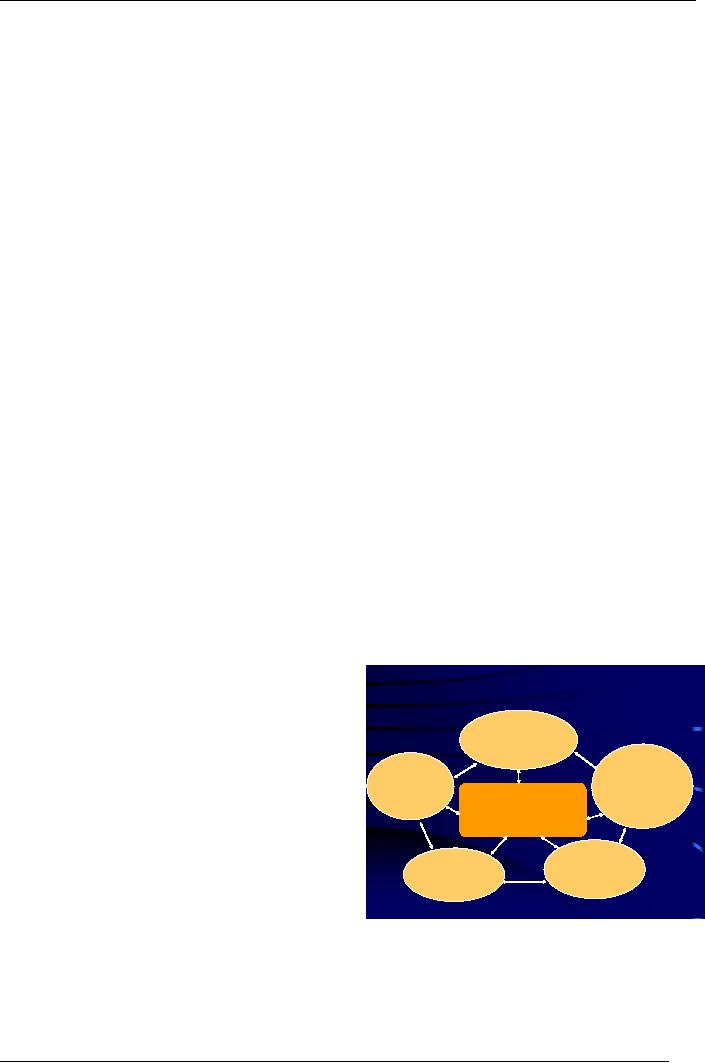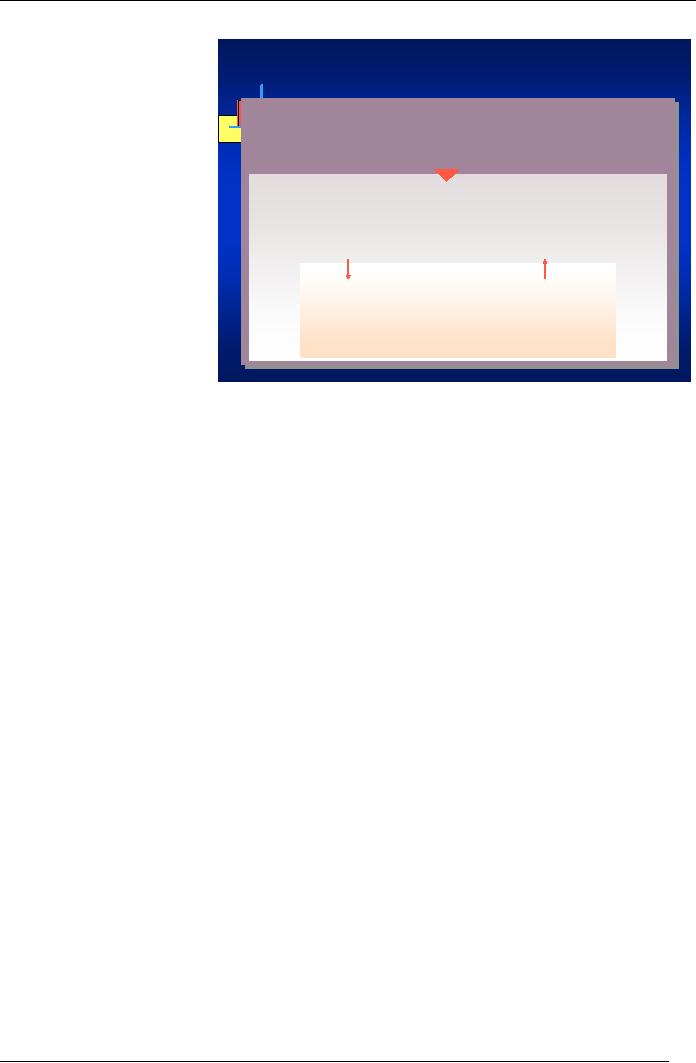 |

Human
Resource Management
(MGT501)
VU
Lesson
9
FUNCTIONS
AND ENVIRONMENT OF HRM
After
studying this chapter, students should be
able to understand the
following concepts:
A.
Functions of Human Resource Management
Department
B.
Environmental Factors influencing HRM
operations
Human
Resource Functions in Small
Businesses
Some
aspects of the human resource
function may actually be
more significant in smaller firms than
in
larger
ones.
Human
Resource Management Functions in
Medium-Sized Firms
As
firms grow and become more
complex, the human resource
function becomes more complex,
and its
function
achieves greater importance. The
basic purpose of human
resource management remains the
same,
but
the approach followed in accomplishing
its objectives
changes.
As
a firm grows, a separate staff
function may be required to coordinate
human resource activities. In
a
larger
firm, the person chosen to do so
will be expected to handle
most of the human resource
activities.
For
a medium-sized firm, there is
little specialization.
Traditional
Human Resource Functions in a Large
Firm
When
the firm's human resource
function becomes too complex
for one person, separate
sections are often
created
and placed under a human
resource manager. These
sections will typically
perform tasks
involving
training
and development, compensation and
benefits, employment, safety and health,
and labor relations.
AN
EVOLVING HR ORGANIZATION FOR
LARGE FIRMS
The
HR organizational structure of large-sized firms
changes as firms outsource, use
company service
centers,
and evolve in other ways to
make HR more strategic.
Regardless of an organization's design,
the
five
functional areas must still
be accomplished. The organizational
mission and corporate culture have
a
major
impact in determining an appropriate HR
organization.
A.
Functions of HRM department:
a.
Staffing
An
organization must have qualified
individuals, in specific jobs at specific
places and times, in order
to
accomplish
its goals. Obtaining such
people involves
Huma
n R e s ourc e Ma na g e me nt
job
analysis, human resource
planning, recruitment,
Func
tions
and
selection. Job
analysis is the
systematic process of
determining
the skills, duties, and knowledge
required
Staffing
for
performing specific jobs in an
organization. Human
resource
planning (HRP) is the
process of systematically
Employee
Human
reviewing
human resource requirements to
ensure that
&
Labor
Resource
HUMAN
RESOURCE
the
required numbers of employees, with the
required
Relations
Development
MANAGEMENT
skills,
are available when needed.
Recruitment
is
the
FUNCTIONS
process
of attracting such individuals in
sufficient
numbers
and encouraging them to apply for
jobs with
Compensation
Safety
&
the
organization. Selection
is the
process through which
&
Benefits
Health
the
organization chooses, from a group of
applicants,
those
individuals best suited both
for open positions
and
for the company.
b.
Human Resource
Development
A
major HRM function that consists
not only of training and
development but also individual
career
planning
and development activities and
performance appraisal, an activity
that emphasizes T&D
needs.
Training
is
designed to provide learners
with the knowledge and skills
needed for their present
jobs.
45

Human
Resource Management
(MGT501)
VU
Development
involves
learning that goes beyond today's
job; it has a more long-term
focus. Human resource
development
(HRD) helps individuals, groups,
and the entire organization become more
effective. It is
essential
because people, technology, jobs,
and organizations are always
changing.
Career
planning is an ongoing process
whereby an individual sets
career goals and identifies the
means to
achieve
them. Career development is a formal
approach used by the organization to
ensure that people
with
the
proper qualifications and experiences
are available when needed.
Through performance
appraisal,
employees
and teams are evaluated to
determine how well they are
performing their assigned
tasks.
c.
Compensation and Benefits
The
term compensation includes all
rewards that individuals
receive as a result of their employment.
The
reward
may be one or a combination of the
following:
Pay: The
money that a person receives
for performing a job.
Benefits:
Additional financial rewards other
than base pay include paid
vacations, sick leave,
holidays,
and
medical insurance.
Non
financial rewards: Non
monetary rewards, such as enjoyment of
the work performed or a
pleasant
working environment.
d.
Safety And Health
Safety
involves protecting employees
from injuries caused by work-related
accidents. Health refers to
the
employees'
freedom from illness and
their general physical and
mental well-being. These aspects of the
job
are
important because employees
who work in a safe
environment and enjoy good health
are more likely to
be
productive and yield
long-term benefits to the organization.
e.
Employee And Labor
Relations
Since
1983, union membership has
fallen approximately 8 percent, to only
13.9 percent of the
workforce,
the
lowest level since the Great
Depression. Subtracting government
employees, unions represent only
9.5
percent
of the private industry workforce.
Even so, a business firm is
required by law to recognize a
union
and
bargain with it in good
faith if the firm's employees want the
union to represent them. In the
past, this
relationship
was an accepted way of life
for many employers. But
most firms today would like to
have a
union-free
environment.
f.
Human Resource
Research
Although
human resource research is
not listed as a separate
function, it pervades all HRM
functional areas,
and
the researcher's laboratory is the entire
work environment.
g.
Interrelationships of HRM Functions
All
HRM functional areas are
highly interrelated. Management must
recognize that decisions in
one area will
affect
other areas. The interrelationships
among the five HRM functional
areas will become more
obvious
as
we address each topic
throughout the book.
46

Human
Resource Management
(MGT501)
VU
B.
The Dynamic Human Resource
Management Environment
Many
interrelated factors affect
Key
HR Challenges for Today's
Managers
human
resource management.
Such
factors are part of
either
Environment
the
firm's
external
∑
Rapid
Change
∑
Legislation
environment
or its internal
∑
Workforce
Diversity
∑
Evolving
Work and Family
Roles
environment.
The firm often
∑
Globalization
∑
Skill
Shortages and the
Rise
∑
Rise
of Internet
of
the Service
Sector
has
little, if any, control
over
Organization
how
the external environment
∑
Self-Managed
Work Teams
∑
Competitive
Position: Cost,
affects
management of its
∑
Small
Businesses
Quality,
Distinctive Capabilities
human
resources. In addition,
∑
Organizational
Culture
∑
Decentralization
there
are
certain
∑
Technology
∑
Downsizing
∑
Outsourcing
∑
Organizational
Restructuring
interrelationships
that
Individual
complicate
the management of
∑
Matching
People and
Organization
human
resources.
∑
Ethical
Dilemmas and Social
Responsibility
∑
Productivity
∑
Empowerment
∑
Brain
Drain
∑
Job
Insecurity
Prentice
Hall, © 2003
I.
External
Environmental Factors
External
Environmental factors Comprised of
those factors that affect a
firm's human resources
from
outside
the organization's boundaries.
a.
The
Labor Force
The
labor force is a pool of individuals
external to the firm from which the
organization obtains its workers.
The
capability of a firm's employees
determines to a large extent how
well an organization can perform
its
mission.
b.
Legal
Considerations
Another
significant external force affecting human resource
management relates to federal,
state, and local
legislation
and the many court decisions
interpreting this legislation. In addition,
many presidential executive
orders
have had a major impact on
human resource
management.
c.
Society
Society
may also exert pressure on
human resource management. If a
firm is to remain acceptable to
the
general
public, it must be capable of
accomplishing its purpose in
line with societal norms.
Social
responsibility
is an implied, enforced, or felt
obligation of managers, acting in
their official capacities,
to
serve
or protect the interests of groups
other than
themselves.
d.
Unions
Union
is a group of employees who
have joined together for the
purpose of dealing collectively with
their
employer.
Although unions remain a powerful force,
union membership as a percentage of
the
nonagricultural
workforce slipped from 33 percent in
1955 to 9.5 percent
today.
e.
Shareholders
The
owners of a corporation are
concerned about shareholders. Because
shareholders have invested
money
in
a firm, they may at times
challenge programs considered by
management to be beneficial to the
organization.
f.
Competition
For
a firm to succeed, grow, and
prosper, it must be able to maintain a
supply of competent
employees.
Other
organizations are also
striving toward that
objective.
47

Human
Resource Management
(MGT501)
VU
g.
Customers
Because
sales are critical to the firm's
survival, management has the task of
ensuring that its
employment
practices
do not antagonize the members of the
market it serves.
h.
Technology
As
technological changes occur, certain
skills are no longer required. This
necessitates some retraining
of
the
current workforce. The trend
toward a service economy
also affects the type and amount of
technology
needed.
i.
The
Economy
The
economy of the nation--on the whole--and
of its various segments is a major
environmental factor
affecting
human resource management. As a
generalization, when the economy is
booming, it is often
more
difficult
to recruit qualified workers. On the
other hand, when a downturn
is experienced, more
applicants
are
typically available.
THE
EXTERNAL ENVIRONMENT: PROACTIVE VERSUS
REACTIVE APPROACH
Managers
approach changes in the external
environment proactively or reactively.
a.
Proactive
Response
Proactive
responsiveness involves taking action in
anticipation of environmental
changes.
b.
Reactive
Response
Reactive
response involves simply reacting to
environmental changes after they occur.
Organizations exhibit
varying
degrees of proactive and reactive
behavior.
II.
The
Internal Environment
Factors
that affect a firm's human
resources from inside its
boundaries are termed as
internal environmental
factors.
The primary internal factors include the
firm's mission, policies, corporate
culture, management
style
of upper managers, employees, the
informal organization, other units of the
organization, and unions.
a.
Mission
the
organization's continuing purpose or
reason for being. Each
management level should operate with
a
clear
understanding of the firm's mission. In
fact, each organizational unit
(division, plant, and
department)
should
clearly understand objectives
that coincide with that
mission.
b.
Policies
A
predetermined guide established to
provide direction in decision
making. As guides, rather than as
hard-
and-fast
rules, policies are somewhat
flexible, requiring interpretation
and judgment in their use.
They can
exert
significant influence on how managers
accomplish their
jobs.
c.
Corporate Culture
The
system of shared values,
beliefs, and habits within
an organization that interacts with the
formal
structure
to produce behavioral norms.
d.
Management
Style of Upper Managers
Closely
related to corporate culture is the way in
which the attitudes and preferences of
one's superiors
affect
how a job is done. This situation
deserves special emphasis
here because of the problems
that can
result
if the managerial style of upper-level
managers differs from that
of lower-level managers.
e.
Employees
Employees
differ in many ways
including their capabilities,
attitudes, personal goals,
and personalities. As a
result,
behavior that a manager
finds effective with one
worker may not be effective
with another.
f.
Informal
Organization
the
informal organization is the set of
evolving relationships and patterns of
human interaction within
an
48

Human
Resource Management
(MGT501)
VU
organization
that are not officially
prescribed. Such informal relationships
are quite powerful.
g.
Other
Units of the
Organization
Managers
must be keenly aware of interrelationships
that exist among divisions or
departments and should
use
such relationships to their best
advantage.
h.
Labor-Management
Agreement
Upper
management typically negotiates
labor-management agreements, but
managers throughout the
organization
must implement the terms of the
agreements. In most instances,
agreements place
restrictions
on
the manager's actions.
C.
MANAGING THE DIVERSE
WORKFORCE
Any
perceived difference among people: age,
functional specialty, profession,
sexual orientation,
geographic
origin,
life style, tenure with the organization,
or position.
a.
Single
Parents and Working
Mothers
The
number of nontraditional, single-parent
households in the United States is
growing. Because more
than
half
of all marriages today end in divorce,
this trend is expected to continue.
Often, one or more
children
are
involved. Of course, there
are always widows and
widowers who have children
as well, and there
are
some
men and women who
choose to raise children
outside of wedlock.
b.
Women
In Business
The
number of women in entry and
midlevel managerial positions has
risen from 34 percent in
1983 to 46
percent
in 1998, meaning many more
women are in the pipeline to
executive spots. Today,
there are more
than
9 million women-owned businesses, up from
400,000 in 1972.
c.
Dual-Career
Families
The
increasing number of dual-career families
presents both challenges and
opportunities for
organizations.
As
a result of this trend, some firms have
revised their policies
against nepotism to allow both
partners to
work
for the same company. Other
firms have developed polices to assist
the spouse of an employee who
is
transferred.
When a firm wishes to
transfer an employee to another location, the
employee's spouse may
be
unwilling
to give up a good position or may be
unable to find an equivalent position in
the new location.
Some
companies are offering
assistance in finding a position
for the spouse of a transferred
employee.
d.
Workers
Of Color
Workers
of color often experience
stereotypes about their group
(Hispanics, African Americans,
Asians,
etc.).
At times, they encounter misunderstandings
and expectations based on ethnic or
cultural differences.
e.
Older
Workers
The
world population is growing
older, a trend that is
expected to continue through the year
2000. In
addition,
the trend toward earlier retirement
appears to be reversing itself.
f.
Persons
With Disabilities
A
handicap, or disability, limits the
amount or kind of work a person
can do or makes
achievement
unusually
difficult.
g.
Young
Persons With Limited
Education Or Skills
Each
year thousands of young, unskilled
workers are hired, especially
during peak periods, such as
holiday
buying
seasons. In general, they have
limited education--high school or
less. More jobs can be
de-skilled,
making
it possible for lower-skilled workers to
do them.
h.
Educational
Level Of Employees
Another
form of diversity that is now
found in the workplace is that of the
educational level of employees.
The
United States is becoming a
bipolar country with regard
to education, with a growing number of
very
educated
people on one side and an
alarming increase in the illiteracy rate
on the other.
49

Human
Resource Management
(MGT501)
VU
i.
Corporate
Culture
Corporate
Culture is the system of shared values,
beliefs, and habits within
an organization that interacts
with
the formal structure to produce behavioral
norms. It is the pattern of basic
assumptions, values,
norms,
and artifacts shared by organizational
members.
Key
Terms
Corporate
Culture The
system of shared values,
beliefs, and habits within
an organization that interacts
with
the formal structure to produce
behavioral norms
Mission:
The
organization's continuing purpose or
reason for being.
Policies:
A predetermined
guide established to provide
direction in decision-making
The
Labor Force: The
labor force is a pool of individuals
external to the firm from which the
organization
obtains
its workers
Unions:
Union is a group of employees
who have joined together for
the purpose of dealing
collectively
with
their employer.
50
Table of Contents:
- INTRODUCTION TO HRM:Growing Importance of HRM, Road Map of the Course
- ESSENTIALS OF MANAGEMENT:Concepts and Essential of Management, Managerís Roles
- ORGANIZATION AND COMPONENTS OF ORGANIZATION:Open versus Closed Systems, The Hawthorne Studies
- PEOPLE AND THEIR BEHAVIOR:Why to work in organizations?, The Goals of Organizational Behavior
- INDIVIDUAL VS. GROUP BEHAVIOR:What Are Roles?, Problem solving Team
- PERSONNEL MANAGEMENT TO HUMAN RESOURCE MANAGEMENT:Records and Administration, Competitive Advantage
- HRM IN A CHANGING ENVIRONMENT:Productivity, New Trends at Work Place
- How organization Cultivate a Diverse Workforce, STEPS TOWARD MANAGEMENT OF DIVERSITY
- FUNCTIONS AND ENVIRONMENT OF HRM:Compensation and Benefits, Safety And Health, Interrelationships of HRM Functions
- LINE AND STAFF ASPECTS OF HRM:Authority, Line versus Staff Authority, Staff Manager
- LEGAL CONTEXT OF HR DECISIONS:Doing the Right Thing, Affirmative Action, Unintended Consequences
- HUMAN RESOURCE PLANNING (HRP):Benefits of HR Planning, Forecasting Human Resource Availability
- STRATEGIC PLANNING AND HRIS:HRís Strategic Role, Human Resource Information System, Common HRIS Functions
- JOB ANALYSIS:Purposes of the job Analysis, Questions Job Analysis Should Answer
- JOB ANALYSIS:Methods of Collecting Job Analysis Information, Observation, Source of Data
- JOB ANALYSIS (CONTD.):SURPLUS OF EMPLOYEES FORECASTED, Diversity through Recruiting Efforts
- SOURCES OF RECRUITMENT:ALTERNATIVES TO RECRUITMENT, Quantity of the Applicants, Quality of the Applicants
- SELECTION:Initial Screening, Advantages of Successful Screening
- SELECTION TESTS:Characteristics of Properly Designed Selection Tests, Guidelines for Conducting an Interview
- SELECTION PROCESSÖ CONTD:Background Investigations, Physical Exam, Selecting Managers
- SOCIALIZATION:Compensation and Benefits, Team Membership, Stages in socialization Process, Training and Development Trends
- TRAINING AND DEVELOPMENT:Learning, Phases of Training, Why Transfer of Training Fails
- MAXIMIZING LEARNING:Following up on Training, Repetition, Feedback, Purposes of T & D
- CAREER MANAGEMENT:Individual career planning, Career Planning and Development Methods
- PERFORMANCE:Determinants of Job Performance, Why is performance measured?, Performance Management
- PERFORMANCE APPRAISAL:What to Evaluate, The Appraisal Interview, PROBLEMS IN PERFORMANCE APPRAISAL
- JOB EVALUATION AND PRICING:THE APPRAISAL PERIOD, Ranking method,
- COMPENSATION SYSTEM:Pay, Job Pricing, Compensation: An Overview, Compensation Surveys
- BENEFITS:Total Compensation, Discretionary Benefits (Voluntary), Workplace Flexibility
- ROLE OF MONEY IN PERFORMANCE OF EMPLOYEES:Types of Pay-for-Performance Plans, Empower Employees
- MOTIVATION:The Motivation Process, Motivational Theories, Challenges of motivating employees
- OCCUPATION, HEALTH & SAFETY:Physical Conditions, Accident Investigation, Smoking in The work place
- STRESS MANAGEMENT:Symptoms of Stress, Managing Stress,
- COMMUNICATION IN ORGANIZATION:Burnout, Social Support at Work & Home, Communication in organization, Meetings
- TRADE UNIONS:Collective Bargaining, The HRM Department in a Nonunion Setting, Phases of Labor Relations
- CONFLICT AND NEGOTIATION:Transitions in Conflict Thought, Individual Conflict Management Styles
- POWER AND POLITICS:Sources of Power, Advantages and Disadvantages of PowerPower and Politics in Context
- EMPLOYEE RIGHTS AND DISCIPLINE:Contractual Rights, Management Rights, Disciplining Employees,
- DISCIPLINE (CONT...):Factors to Consider when Disciplining, Disciplinary Guidelines, Employee Separations
- LEADERSHIP:The Leaderís Behavior, Situational Theories of Leadership, Becoming a Leader
- REVISION (LESSON 12-21):Plans, Job Specification, Human resource planning, Selection Process, Corporate Culture
- REVISION (LESSON 22-26):Training, Case Study Method, Training, Performance
- REVISION (LESSON 27-35):Classification Method, Compensation, Empowerment, Mediation
- INTERNATIONAL DIMENSIONS OF HRM:Global Corporation, Type of staff members, Approaches to Global Staffing
- CONCLUSION & REVIEW:Strategies for Gaining Competitive Advantage, High-performance Work System